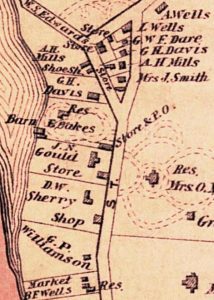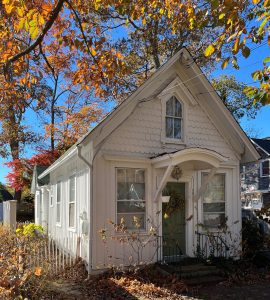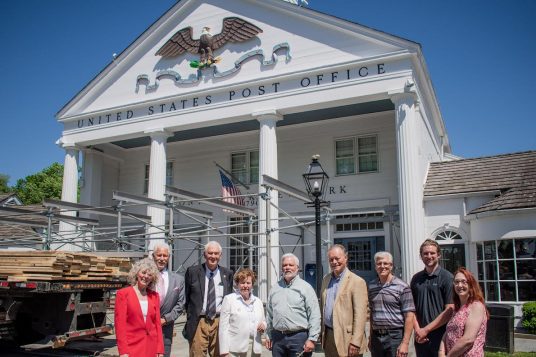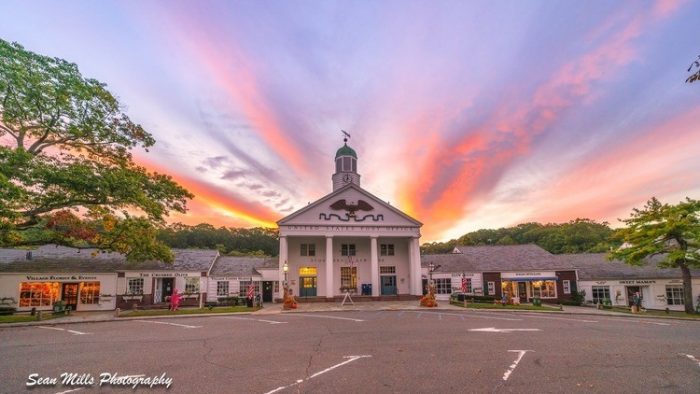John Dielman of East Setauket snapped this photo of the Stony Brook Post Office and its famous eagle all dressed up for the holidays on the evening of December 23.
Send your Photo of the Week to [email protected]
John Dielman of East Setauket snapped this photo of the Stony Brook Post Office and its famous eagle all dressed up for the holidays on the evening of December 23.
Send your Photo of the Week to [email protected]
By Beverly C. Tyler
The post office in Stony Brook has a long history of service to the community. Until the 20th century, the postmaster was the only person authorized to handle letters and write money orders. Each rural post office had one representative of the postal system, the postmaster, who was appointed by the president of the United States with the advice and consent of the Senate.
A postal system existed in Massachusetts as early as 1639. In 1672, New York Gov. Lovelace established service between New York and Boston along the future Boston Post Road. Benjamin Franklin was appointed Postmaster General for the British Colonies in America in 1753 and served until 1774, when he was dismissed by the Crown. He was reappointed by the Continental Congress in 1775 and served for 15 months, establishing a sound postal system. The U.S. postal system was created when Samuel Osgood was appointed the first Postmaster General on Sept. 26, 1789.

The first Stony Brook postmaster was Nathaniel Hallock. According to National Archives records, he was appointed on March 21, 1826, and served until June 24, 1836. Little is known about Hallock or his post office, but it was likely part of a general store, as was typical of post offices on Long Island in the 19th century.
The cost of posting a letter weighing less than 1 ounce was six cents until 1847, when stamps were first issued. Letters were single sheets of paper folded, addressed, and delivered for six cents within 30 miles. Beyond 30 miles or for heavier letters, the cost increased slightly, with a maximum charge of 25 cents for a letter traveling more than 400 miles. For example, a letter sent to “Mr. William S. Mount – Stony Brook – Long Island – N.Y.” in 1841 from Monticello, Georgia, was marked, folded, sealed, and addressed in the customary manner of the time.
The second Stony Brook postmaster was James N. Gould, who was appointed in 1836 and served until 1861. He was reappointed on March 29, 1867, and served until 1870. Gould owned and operated a general store, which was located just north of where the Reboli Center now stands. The store was demolished before 1900, as was Gould’s home, which stood just north of the store. Both were removed to make way for the village improvements in the 1940s by Ward Melville.
According to local lore, it was said to be impossible to ask for any item James Gould didn’t have in his store. On a bet, a customer once asked for a pulpit, and Gould amazed everyone by producing one from the store’s attic.
The third postmaster, Edward Oakes, began his service in 1861 as the Civil War began at Fort Sumter. He served until 1867, when James Gould resumed the position. During this period, the post office introduced the money order system in 1864 to allow soldiers to send money home. Only the postmaster could process money orders, as he was the sole postal employee.
Oakes’ general store was located north of Gould’s store and home, on the west side of the business triangle along what was then Main Street. Residents recalled a long horse block in front of the store where men gathered for evening chats. Oakes served as postmaster again from 1870 to 1885. During this time, the store was known as “Oakes and Topping,” later “Topping and Smith,” and eventually, around 1901, “E.E. Topping.”
William O. Gould succeeded Oakes as postmaster in 1885, taking over his father’s general store. He served until 1889, during which time the post office expanded its services. In 1885, the special delivery service was introduced, allowing for prompt mail delivery, which marked a shift from the rural post office’s general store model to independent operations.
From 1889 through the end of the century, Stony Brook had five postmasters. John W. Copley was appointed in 1889, followed by David R. Rayner in 1892. Charles J. Williamson succeeded Rayner on Aug. 4 of that year. William O. Gould returned as postmaster in 1893. On May 1, 1895, Nellie E. Smith became Stony Brook’s first female postmaster. In 1898, Daniel W. Arnold became postmaster, serving for less than two years.
The turn of the century brought stability to the post office as it continued to grow and adapt to the needs of the community.
Beverly C. Tyler is the Three Village Historical Society historian and the author of books available from the Three Village Historical Society, 93 North Country Road, Setauket. Tel: 631-751-3730.

By Beverly C. Tyler
As detailed in my article on Nov. 7, 2024, the first Stony Brook Post Office built specifically for postal use was located on Main Street, a few hundred feet north of where the Reboli Center stands today.
As World War I approached, Stony Brook saw a new postmaster. Nellie E. Lempfert began serving the community on Jan. 24, 1913. According to Olga Reboli, she was a very nice person and a good postmaster.
Mrs. Reboli also recalled that Nellie Lempfert had an ice cream parlor before becoming postmaster. It was next to the big building on the corner near Mr. Rogers’ plumbing shop.
In 1913, Mrs. Reboli, then 12 years old, and her sisters would occasionally spend a nickel on ice cream at Mrs. Lempfert’s store. “We didn’t have a nickel to spend very often,” she said, “but it was always a special time to remember.”

The Stony Brook Post Office was also remembered by Orietta Peterman, who shared her vivid recollections of working there.
“Mrs. Lempfert was the postmaster, and I went to work there in October 1913,” Ms. Peterman explained. “I was married in 1917, and my husband went off to World War I. He left in 1919.” (Note: Charles C. Peterman was inducted into the U.S. Army in December 1917 and served in Europe from March 1918 until his discharge on Feb. 2, 1919.)
When Ms. Peterman started at the post office, there were only two workers, and only one person worked at a time. “On Mondays, I had to be in by 6 o’clock to get the morning mail off, all by myself,” she said. “If anyone came in to buy stamps, I did that. If someone wanted a money order, I did that too. We didn’t even have a safe until a year or two later. When the post office started growing, they finally bought a safe to keep the money in.”
She described her postmaster’s schedule, explaining that Mrs. Lempfert would probably arrive around 8 o’clock. She stayed to help with the morning mail before heading home. “I was there most of the time, earning $5 a week for a 14-hour day,” she said.
The space itself was challenging to work in. Ms. Peterman remembered that the post office wasn’t used very long and was already outgrowing its capacity. “Two people were always in the way. There were no facilities, no water. If we needed water, I had to fetch it from a spring near the Sherry house. For hot water, we used a kerosene space heater with a tea kettle on top,” she explained.
“In winter, there was a coal stove that needed tending daily,” she added. “I handled all the cleaning, and since there was no electricity, I cleaned lamp chimneys and filled the lamps.”

Reflecting on her experience, Ms. Peterman said she did everything under heaven. “I never had a coffee break in my life. I worked there for seven or eight years, with no vacation and no paid days off. Even on the day I got married, I was docked. That’s how liberal they were.”
On April 29, 1922, Louise E. Wells was appointed the next postmaster of Stony Brook, operating from the same building. Miss Wells married Charlie Williamson in 1926 and remained postmaster until mid-1932. Olga Reboli remembered her fondly and said Mrs. Williamson was also a very nice person. The couple had two daughters, Louise and Madeline.
In the early 1930s, a new post office was built next to the old firehouse on Christian Avenue. Though not much larger, it offered more modern facilities.
The old post office wasn’t forgotten. By 1922, it became a butcher shop for Percy W. Smith and later served as the office for L.C. Clarke Co. In 1925, Olga Reboli worked for L.C. Clarke Real Estate and was photographed in front of the building.
The venerable old structure was eventually moved in the 1940s and repurposed as a home. It now resides at 44 Cedar St. in Stony Brook, just north of Hollow Road.
Beverly C. Tyler is an author and historian with the Three Village Historical Society. For more information, visit www.tvhs.org.


The Ward Melville Heritage Organization (WMHO) recently announced the successful restoration of the iconic Stony Brook Eagle, a beloved landmark perched atop the historic Stony Brook Post Office. After 83 years of service, the eagle has been meticulously restored thanks to the unwavering support of local and dedicated community members. The restoration was completed just in time for Memorial Day, allowing the patriotic eagle to be displayed for the holiday.
Built in 1940 and completed in 1941 by the visionary businessman and philanthropist Ward Melville, Stony Brook Village stands as a testament to his grand vision. Among the thirty-five buildings modified or relocated by Melville, the Post Office stands out with its remarkable 20-foot mechanical eagle, captivating generations of visitors with its lifelike movements. However, after so many years in service, the hand-carved wooden fixture was in need of restoration.
Suffolk County Legislator Steve Englebright successfully secured a $125,000 grant to restore several of the Ward Melville Heritage Organization’s (WMHO) historic properties, including the eagle. To supplement the grant, WMHO launched a fundraising campaign. This campaign reached people through newsletters, social media, and word-of-mouth, drawing donations from a diverse group of supporters. Contributions came from former and current residents, locals from neighboring towns, and eagle enthusiasts from as far away as San Antonio, Texas.
Olivia and Harlan Fischer, Branch Financial Services made a significant donation. Frederick, Jeannie, and Margeaux Ringwald, grandchildren of Friederich Wilhelm Ringwald, the man who carved the 20-foot eagle in the 1940s, also donated to the cause. The restoration, totaling $85,000, was fully funded by the donations specifically raised for the eagle.
Renowned for their expertise in historic restoration, Henry Restoration Ltd. of Nesconset was entrusted with the project. With a reputation built on prestigious projects like the Sheraton St. Regis Hotel and Trinity Church in New York City, the company commenced work on April 2nd, completing the project in less than seven weeks. WMHO worked closely with Timothy Henry, President of Henry Restoration Ltd. on the restoration.
Sidewalk bridging and scaffolding were constructed at the Post Office to facilitate the restoration work. Missing, loose, and broken parts, including the feet and arrowheads, were expertly restored or replaced. New stars, crafted from mahogany by Carl Reinke, Vice President of Henry Restoration Ltd., replaced the original Masonite stars.
Enhancements included aluminum straps for wing stabilization and a new stainless-steel chain to replace a rusty steel one. The eagle has been reconnected to its internal clock mechanism, which remains in excellent working condition. This ensures it will continue to flap its wings every hour, on the hour, from 8 a.m. to 8 p.m. daily, captivating onlookers for years to come.
This project stands as a testament to the community’s commitment to preserving its rich heritage and honoring the legacy of Ward Melville. WMHO has established a dedicated fund to support the eagle and its mechanisms moving forward. Checks can be made payable to the Ward Melville Heritage Organization, and can be sent to P.O. Box 572, Stony Brook, NY 11790. Your donation is tax-deductible.
The Ward Melville Heritage Organization has announced the in-person return of its annual fundraiser, the Summer Soirée. The event will be held on Thursday, June 22 at the newly renovated Three Village Inn in Stony Brook, “where it all began.”
The event will raise funds to support the restoration of the 20’ wooden eagle that is affixed to the pediment above the Stony Brook Post Office. This beloved local and national treasure has flapped its wings every hour on the hour for over 80 years.
Funds raised will also support two new engines for the Discovery Pontoon boat, digitizing Ward Melville’s archives, repairs to the roof at the Brewster House (c.1665), a new exhibit at the Thompson House (c.1709), as well as education programs.
The benefit will honor community members Katharine Griffiths, Director of Avalon Park and Preserve; Olivia and Harlan Fischer; Sally Lynch, President of Old Field Farm Ltd.; Nicole Sarno, Business Managing Director, Business Banking, Webster Bank; and awarded posthumously, philanthropist Judi Betts.
One of the highlights of the event will be a live auction where one of the many wonderful items will be a painting of the Stony Brook Post Office by Setauket artist Dino Rinaldi who has been working on creating this beautiful work of art on the Village Green over the last few weeks.
The WMHO will take phone call bids for the painting from the public until 5 p.m. on June 21. Valued at $1,200, bids for the painting will begin at $400. The successful bidder of the painting will be announced on June 22 and will receive a phone call or email the following day.
For further information, please call 631-751-2244.
Atop Stony Brook Village’s post office is the only mechanical eagle in the world that flaps its wings, every hour on the hour from 8 a.m. to 8 p.m. Although the eagles wings are still flapping after 82 years of service, the hand-carve wooden fixture is in need of restoration. Funds are being raised by the 501(c)3 not-for-profit corporation Ward Melville Heritage Organization (WMHO) to help the eagle soar once more.
Stony Brook Village was constructed in 1941 by businessman and philanthropist, Ward Melville. At his own expense, he relocated, demolished, or modified some thirty-five buildings in the downtown area. The enormous undertaking also included the rerouting of roads, the relocation of large trees, and moving one million cubic yards of dirt. Although the construction of the village was impressive, Ward Melville’s centerpiece gem was the 20’ mechanical Stony Brook Eagle.
For generations, visitors of Stony Brook Village have been awed by the eagle’s mechanical movements. Watching the wings of the eagle flap is a childhood memory thousands cherish. Since the inception of fundraising, donations to restore the eagle have come from all over the United States, from coast to coast.
Fundraising efforts by the WMHO include: The Summer Soirée, a fundraising gala with a cocktail hour, dinner and live auction at the historic Three Village Inn on Thursday, June 22, and an online auction beginning May 22, with exciting items such as a real military tank driving experience for 30 people in “The Scorpion” British armored reconnaissance vehicle, a suite for up to 22 people at the Total Mortgage Arena, and an all-inclusive stay for seven nights in a three room, five-star Panamanian boutique inn.
While the primary purpose of the fundraising is to support the restoration of the beloved eagle, any additional funds raised may also support two new engines for the WMHO’s Discovery Pontoon Boat, digitizing Ward Melville’s archives, repairs to the roof at the Brewster House (c. 1665), a new exhibit at the Thompson House (c. 1709) in Setauket, as well as education programs.
Donations are being accepted now. To help support the WMHO in its fundraising efforts, visit wmho.org or call 631-751-2244. Checks can be made payable to the Ward Melville Heritage Organization, and can be sent to P.O. Box 572, Stony Brook, NY 11790. Your donation is tax-deductible to the full extent allowed by the law.

Stony Brook Village has announced that the Stony Brook Village Audio Experience is now available and can be enjoyed on your own time and at your own pace! The experience is free to the public and will allow all visitors of Stony Brook Village to immerse themselves in the quirky history and stories of the lifestyle center and some of its surrounding properties. The audio experience is obtained by scanning QR codes throughout the village and is also available at audio.stonybrookvillage.com.
Currently, the experience has ten stops, and covers the history and the stories from the Three Village Inn’s original residents to the entire development of Stony Brook Village Center. It is recommended that participants of the experience begin at the Three Village Inn. Additional stories about the Country House (c.1710), the Stony Brook Grist Mill (c.1751) — including the first vineyard on Long Island, and T. Bayles Minuse Mill Pond Park will be added soon.
To learn more about events and activities in Stony Brook Village Center, visit stonybrookvillage.com.
The Ward Melville Heritage Organization will host a Holiday Secrets of Stony Brook Village Walking Tour on Wednesday, Dec. 16 at 10:50 a.m. and again at 2:50 p.m.
Participants will experience the unheard stories of some of Stony Brook Village’s illustrious residents and customs through time. This includes “Astor Orphan” Alida Chanler Emmet and the extravagant parties that she hosted at her estate, the Mallows; the origins of the Stony Brook Village and its traditions of gift giving though the centuries; and the forgotten story of painter Ruth Hawkins Mount Seabury who was born on Christmas Day in 1808 and the only sister of the three Mount artists.
The holiday cheer can continue after the walking tour, as the Mirabelle Tavern at the Three Village Inn (c. 1751) and Pentimento Restaurant will be offering ticket holders drink or dessert specials with the purchase of food items.
Tours will leave from the Stony Brook Post Office, 111 Main St., Stony Brook. Tickets for this event are $15 per person and includes fresh hot chocolate from Stony Brook Chocolate Works. Reservations are required by calling 631-751-2244.
